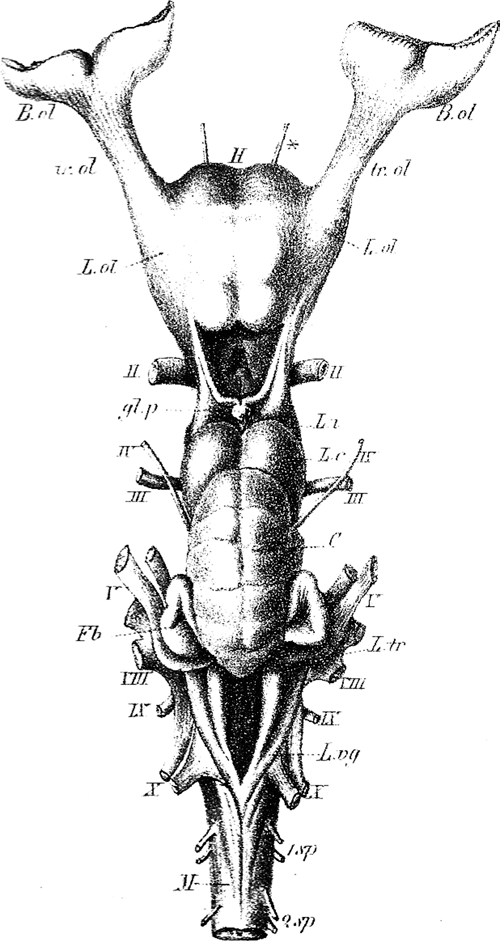Cranial Nerve 0 on:
[Wikipedia]
[Google]
[Amazon]
The terminal nerve, also known as cranial nerve 0 or simply as CN 0, is a
 The terminal nerve appears just anterior of the other cranial nerves bilaterally as a microscopic plexus of unmyelinated
The terminal nerve appears just anterior of the other cranial nerves bilaterally as a microscopic plexus of unmyelinated
File:Johnston Cranial nerve 0.png, Three forms of the nerve on the underside of human brains
File:Sobo 1909 629.png, Brain viewed from below. Gyrus rectus seen at anterior centre.
nerve
A nerve is an enclosed, cable-like bundle of nerve fibers (called axons) in the peripheral nervous system.
A nerve transmits electrical impulses. It is the basic unit of the peripheral nervous system. A nerve provides a common pathway for the e ...
that was not included in the seminal classification of the cranial nerves as CN I through CN XII but is now generally classified as a cranial nerve. It was discovered by German scientist Gustav Fritsch in 1878 in the brains of sharks. It was first found in humans in 1913.
A 1990 study has indicated that the terminal nerve is a common finding in the adult human brain.
The nerve has been called unofficially by other names, including cranial nerve XIII, zero nerve, nerve N,
and NT.
Structure
 The terminal nerve appears just anterior of the other cranial nerves bilaterally as a microscopic plexus of unmyelinated
The terminal nerve appears just anterior of the other cranial nerves bilaterally as a microscopic plexus of unmyelinated peripheral
A peripheral or peripheral device is an auxiliary device used to put information into and get information out of a computer. The term ''peripheral device'' refers to all hardware components that are attached to a computer and are controlled by the ...
nerve fascicle
A nerve fascicle, is a bundle of nerve fibers belonging to a nerve in the peripheral nervous system. A nerve fascicle is also called a fasciculus. A nerve fascicle is enclosed by perineurium, a layer of fascial connective tissue. Each enclosed ...
s in the subarachnoid space
In anatomy, the meninges (, ''singular:'' meninx ( or ), ) are the three membranes that envelop the brain and spinal cord. In mammals, the meninges are the dura mater, the arachnoid mater, and the pia mater. Cerebrospinal fluid is located in th ...
covering the gyrus rectus. This plexus appears near the cribriform plate and travels posteriorly toward the olfactory trigone, medial olfactory gyrus, and lamina terminalis.
The nerve is often overlooked in autopsies because it is unusually thin for a cranial nerve, and is often torn out upon exposing the brain. Careful dissection
Dissection (from Latin ' "to cut to pieces"; also called anatomization) is the dismembering of the body of a deceased animal or plant to study its anatomical structure. Autopsy is used in pathology and forensic medicine to determine the cause o ...
is necessary to visualize the nerve. Its purpose and mechanism of function is still open to debate; consequently, nerve zero is often not mentioned in anatomy textbooks.
Development
The zebrafish was used as a developmental model in research from 2004. The connections between the terminal nerve and the olfactory system have been extensively studied in human embryos. It was found to enter the brain at stages 17 and 18 from olfactory origins.Function
Although very close to (and often confused for a branch of) theolfactory nerve
The olfactory nerve, also known as the first cranial nerve, cranial nerve I, or simply CN I, is a cranial nerve that contains sensory nerve fibers relating to the sense of smell.
The afferent nerve fibers of the olfactory receptor neurons tr ...
, the terminal nerve is not connected to the olfactory bulb, where smells are analyzed. This fact suggests that the nerve is either vestigial or may be related to the sensing of pheromones. This hypothesis is further supported by the fact that the terminal nerve projects to the medial and lateral septal nuclei and the preoptic areas, all of which are involved in regulating sexual behavior in mammal
Mammals () are a group of vertebrate animals constituting the class Mammalia (), characterized by the presence of mammary glands which in females produce milk for feeding (nursing) their young, a neocortex (a region of the brain), fur or ...
s, as well as a 1987 study finding that mating in hamsters is reduced when the terminal nerve is severed.
Additional images
See also
* Vomeronasal organReferences
External links
* * {{DEFAULTSORT:Cranial Nerve Zero Cranial nerves